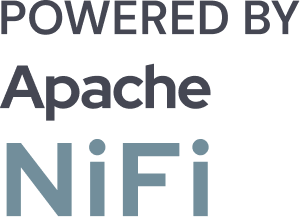Using On-Premise Apache NiFi in Energy Operations for Secure, Real-Time Data Processing
![]()
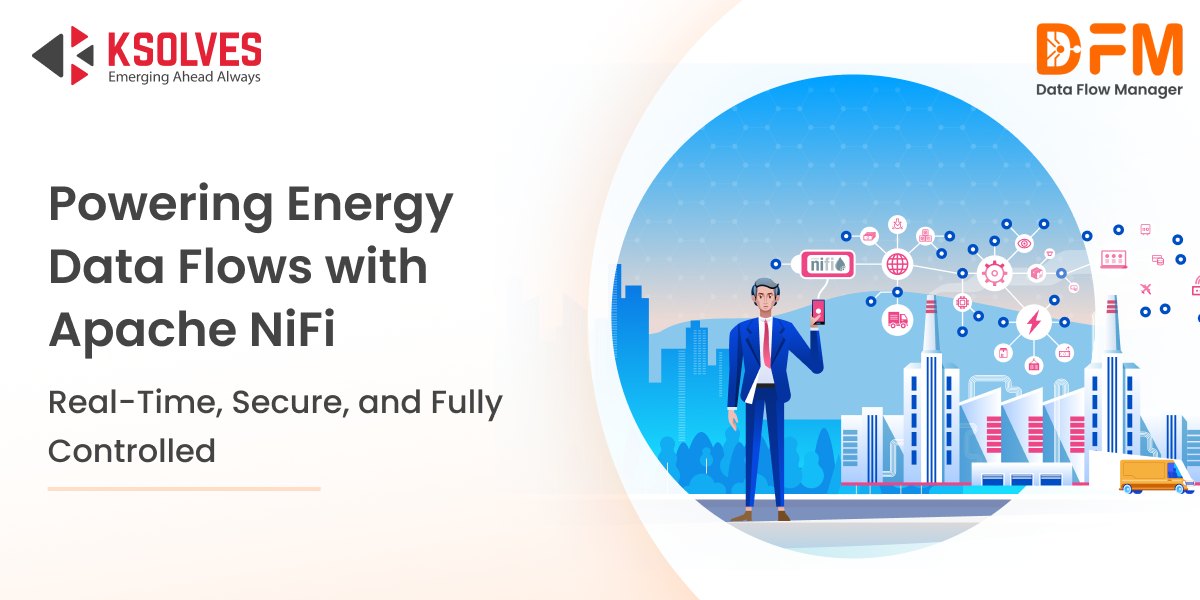
Data is the backbone of modern energy operations. It fuels everything from real-time grid monitoring and predictive maintenance to regulatory compliance and sustainability efforts. From field sensors and smart meters to SCADA systems and industrial IoT devices, energy organizations generate and manage massive volumes of data every second.
But handling this data securely, in real time, and within compliance frameworks, especially across geographically dispersed and critical infrastructure, is not a trivial task.
While cloud platforms offer scalability, they also introduce challenges around latency, data sovereignty, security, and vendor lock-in. That’s where Apache NiFi, particularly when deployed on-premise, becomes a powerful asset.
This blog explores how on-premise Apache NiFi empowers energy companies to process and manage their data locally, securely, and in real time.
Key Data Handling Challenges in Energy Infrastructure
Energy operations face a unique set of data management challenges that stem from the scale, criticality, and distribution of their infrastructure:
- Remote and Distributed Assets
Facilities like substations, pipelines, wind farms, and power plants are often spread across vast and remote geographies. These environments may have limited connectivity, making centralized data processing impractical and error-prone.
- Real-Time Response Requirements
Grid fluctuations, equipment failures, and safety-critical conditions demand instant data processing and decision-making. Delays of even a few seconds can lead to outages, equipment damage, or safety incidents.
- Regulatory and Compliance Pressures
Frameworks such as NERC CIP, ISO 27001, and other regional mandates require strict control over data access, flow tracking, and storage. Ensuring data lineage and auditability is non-negotiable.
- Limitations of Cloud Dependency
Public cloud solutions introduce concerns like latency, intermittent connectivity, and data sovereignty. In mission-critical operations, relying on external infrastructure for real-time processing can compromise both security and reliability.
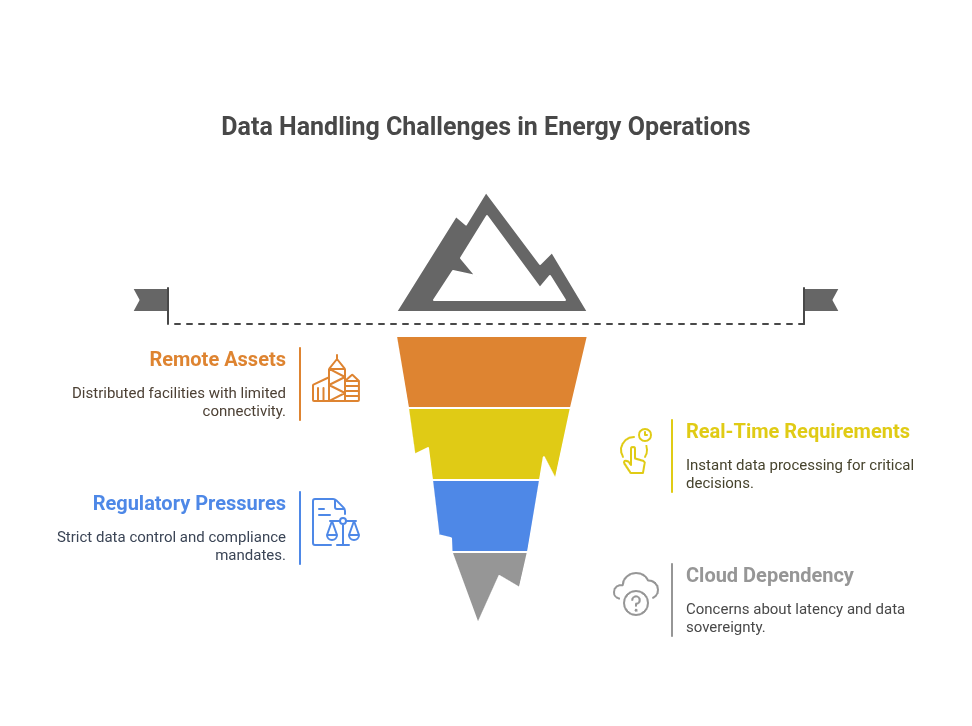
Why Apache NiFi is Ideal for Energy Use Cases
Apache NiFi is a robust data flow automation tool designed to manage complex data pipelines, from data ingestion to delivery, across diverse protocols and systems. Its architecture and feature set align particularly well with the needs of energy operations.
-
Flow-Based Programming
NiFi offers an intuitive, drag-and-drop interface that enables operations and engineering teams to build and modify dataflows without writing custom code. This visual approach simplifies the orchestration of real-time data from various sources and allows for rapid iteration and troubleshooting.
-
Broad Protocol Support
Energy systems rely on a mix of legacy and modern protocols. NiFi supports MQTT, OPC-UA, Modbus, TCP, Kafka, SFTP, HTTP, and more, making it easy to connect with SCADA systems, industrial controllers, IoT sensors, and enterprise applications.
-
Comprehensive Provenance Tracking
NiFi records the full lineage of every data object – what it is, where it came from, how it was transformed, and where it went. This built-in provenance feature is critical for meeting audit and compliance requirements in regulated energy environments.
-
Built-In Security Features
NiFi is designed with enterprise-grade security in mind. It supports TLS for secure communication, role-based access control (RBAC), encrypted content and provenance repositories, and fine-grained authorization policies to safeguard sensitive data.
-
Edge Deployment with MiNiFi
MiNiFi, a lightweight version of NiFi, is purpose-built for edge deployments. It can run on remote devices or gateways, enabling local data collection, filtering, and preprocessing before securely transmitting to central systems, ideal for low-connectivity or bandwidth-constrained environments.
With this combination of flexibility, visibility, and security, Apache NiFi stands out as a practical and future-proof data orchestration solution for energy organizations.
Advantages of On-Premise NiFi Deployment in Energy Environments
Although Apache NiFi supports cloud deployment, many energy organizations find on-premise deployments better aligned with their operational, regulatory, and security needs. Here are the key advantages of running NiFi within your local infrastructure:
- Low Latency Processing
Data is processed where it is generated – no waiting on cloud round-trips. This is critical for load balancing, fault detection, and emergency response.
- Security & Compliance
Sensitive data never leaves the secure perimeter. On-premise NiFi can be deployed within DMZs (demilitarized zone network) or fully air-gapped networks.
- Operational Autonomy
Teams retain full control over configuration, scaling, and access policies, reducing reliance on third-party providers.
- Legacy Integration
Many control systems in energy environments run on legacy protocols. On-prem NiFi simplifies integration without needing cloud adapters or proxies.
- High Availability & Resilience
NiFi supports clustering and site-to-site communication. Even if external connectivity fails, internal systems continue running.
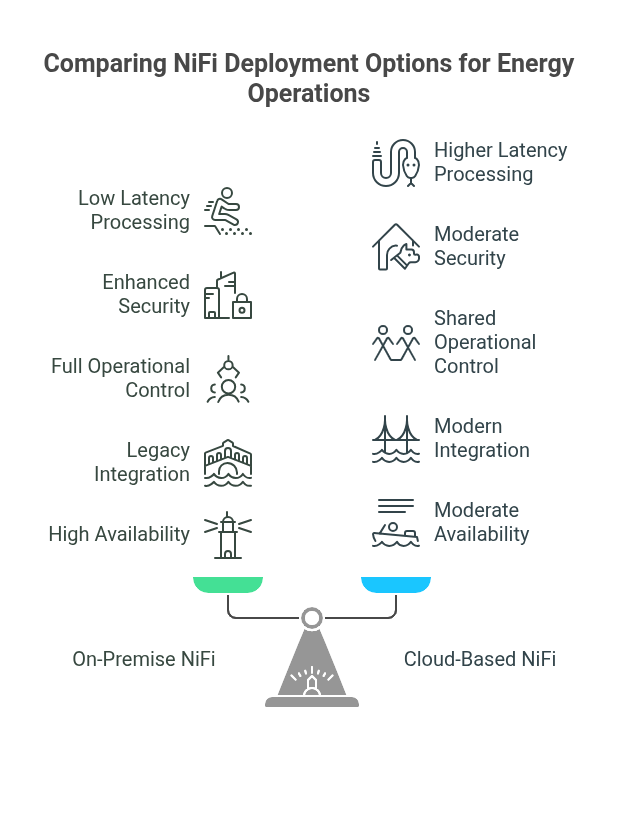
Real-Time Data Processing Use Cases with On-Premise NiFi
Here are practical examples where on-premise NiFi delivers real-time value in energy operations:
1. SCADA & Telemetry Ingestion
SCADA systems continuously produce telemetry data. NiFi can ingest, normalize, and route this data to on-prem databases or event-processing engines for monitoring and historical analysis.
2. Substation Monitoring
Voltage, current, breaker status, and environmental data from substations can be captured and analyzed in real time for predictive maintenance or failure prevention.
3. IoT Device Data Collection
From smart meters to weather stations, NiFi aggregates and cleans data locally, reducing noise and storage costs before forwarding relevant data for deeper analytics.
4. Condition-Based Maintenance
NiFi can define thresholds (e.g., vibration levels or heat spikes) and trigger alerts or generate maintenance tickets through integration with CMMS systems.
5. Regulatory Data Archival
Using NiFi’s data provenance and replay features, organizations can meet strict data retention policies and demonstrate compliance effortlessly.
Also read: 10 Real-World Apache NiFi Use Cases Across Diverse Industries
Best Practices for Managing On-Premise Apache NiFi in Energy Operations
To ensure a secure, resilient, and maintainable on-premise NiFi deployment in energy environments, it’s essential to follow proven best practices that align with both operational and compliance needs.
1. Use NiFi Registry for Flow Versioning
Leverage NiFi Registry to manage version-controlled flows across development, staging, and production environments. This allows teams to collaborate on flow design, roll back to previous versions safely, and standardize deployments across locations.
2. Enforce Robust Security Policies
Implement end-to-end security measures – enforce HTTPS using TLS certificates, configure fine-grained Role-Based Access Control (RBAC), and encrypt both flowfile content and provenance data. These practices help protect critical infrastructure data and support compliance with NERC CIP, ISO 27001, and other regulatory standards.
3. Use Site-to-Site Transfers for Distributed Data Flows
In geographically dispersed energy infrastructures, site-to-site communication ensures secure and efficient data exchange between remote MiNiFi agents, substations, and central NiFi clusters, minimizing the need for complex external network configurations.
4. Deploy MiNiFi for Edge Data Collection
Install MiNiFi agents on remote gateways or field equipment to handle ingestion, filtering, and routing of sensor and telemetry data locally. MiNiFi is designed for constrained environments and supports intermittent connectivity, making it ideal for edge processing in remote or off-grid locations.
5. Monitor System Health and Performance Continuously
Proactively monitor NiFi metrics such as throughput, backpressure, latency, and system load using tools like Prometheus and Grafana or NiFi’s native reporting tasks. Early visibility into flow behavior helps prevent bottlenecks and ensures smooth operations across your data pipelines.
Introducing Data Flow Manager: Unified Control Without the Code to Manage On-Premise Apache NiFi
To simplify and centralize the management of complex, multi-cluster NiFi flow deployments, energy organizations can turn to Data Flow Manager (DFM), a code-free, enterprise-grade platform purpose-built to manage the entire on-premise NiFi ecosystem, from flow creation to deployment and cluster management.
Data Flow Manager empowers teams to:
- Design and deploy flows visually without writing code.
- Version control NiFi flows by integrating with NiFi Registry.
- Enforce RBAC policies for secure, role-specific access to dataflows.
- Monitor flow health and system metrics across all clusters from a single pane.
- Manage promotion of flows across dev, staging, and production environments.
- Audit flows with complete visibility into changes and deployments.
- Install, upgrade, and monitor NiFi clusters.
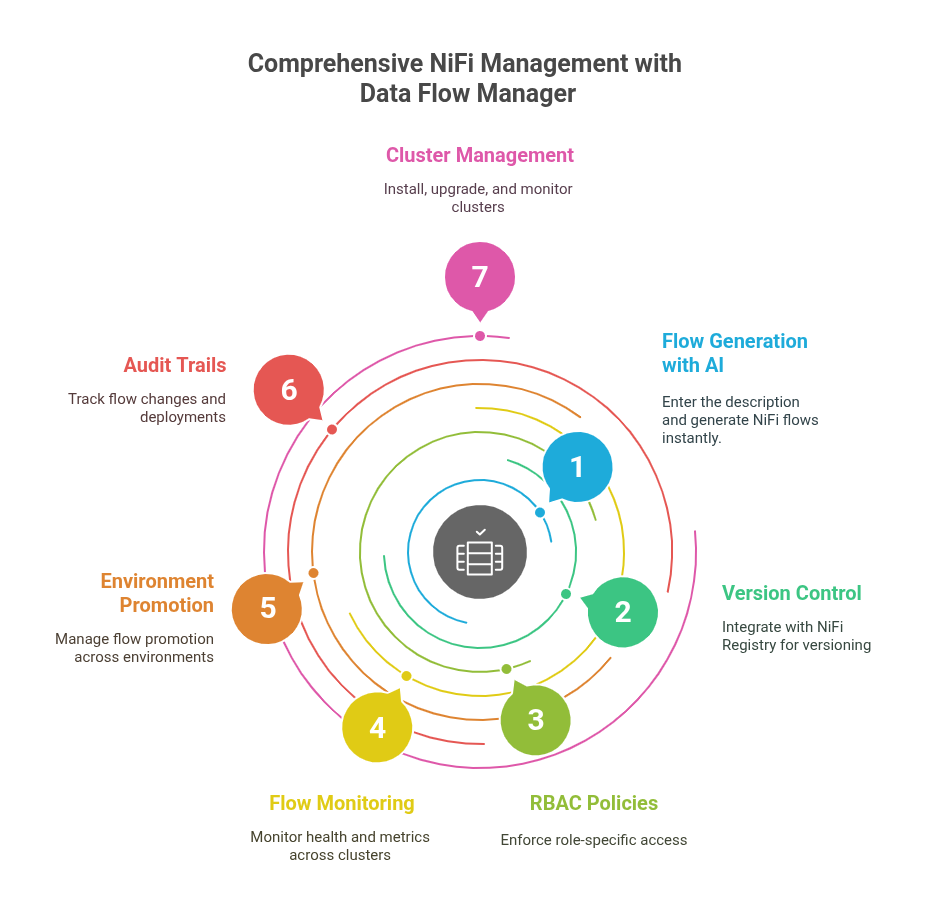
Whether you’re operating one cluster or managing dozens across remote sites and control centers, Data Flow Manager gives you the control, governance, and automation needed to scale NiFi efficiently.
Conclusion
Apache NiFi, when deployed on-premise, provides energy organizations with the control, security, and responsiveness needed to handle real-time data from critical infrastructure. It addresses the unique demands of distributed energy operations, minimizing latency, supporting legacy systems, and ensuring compliance with industry regulations.
By combining NiFi’s powerful flow-based architecture with best practices and tools like Data Flow Manager, enterprises can manage complex data pipelines at scale, without relying heavily on cloud infrastructure. The result is a secure, auditable, and efficient data ecosystem tailored for the evolving needs of modern energy environments.
![]()
